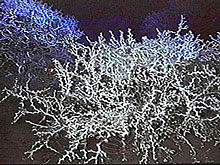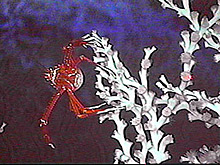
Extensive reefs of the deep-water coral Lophelia near oil platforms off the Mississippi coast. Click image for a larger view.
Discovery of a New Coral Reef
October 18, 2002
Sandra Brooke
Oregon Institute of Marine Biology
When most of us think of coral reefs, we imagine warm shallow seas teeming with colorful fish and invertebrates. Today on our submersible dive we saw an entirely different kind of reef. We landed on a gentle incline at 1,600 feet and proceeded upslope. Out of the gloom white cauliflower shapes appeared and became progressively more prolific as we continued our journey up the craggy slope. Finally, at a depth of 1,500 feet, in the cold darkness of the Gulf of Mexico, the lights of the Johnson Sea-Link submersible revealed an expanse of coral thickets comprised of tangled, branching colonies of deep-water Lophelia coral. Closer inspection revealed many creatures associated with the coral colonies: long-limbed fragile galatheid crabs scavenging amongst the coral polyps, urchins and feathery crinoids nestled amongst the branches, plus a varied assortment of fish.
Lophelia colonies are bright white (like other species of deep-water coral) because they live in total darkness and cannot support the zooxanthellae (algal symbionts) that give many tropical corals their colors. Since zooxanthellae also help provide food for the coral, deep-water ‘azooxanthellate’ species like Lophelia must obtain all their nutrition from small particles such as zooplankton that drift by its stinging tentacles. Coral polyps may look like flowers, but are actually voracious carnivores that wait in ambush for their hapless prey!

A brightly colored galatheid crab perches on delicate branches of Lophelia. Click image for larger view.
Shallow water coral reefs have been called the “rainforests of the sea” because of their extremely high biodiversity and value as an ecosystem. Although deep reefs are composed of few coral species, they have hundreds of different types of invertebrates living in their complex structure, as many in fact as a tropical coral reef. These invertebrates attract larger predators such as fish, which may also use the reefs as aggregation or breeding sites. The high numbers of fish that congregate around these reefs create valuable fisheries, but unfortunately the fragile reef itself can easily be damaged by careless fishing practices.
Lophelia and other similar species of deep-water coral form large reefs in places where current speed is high such as the edge of continental shelves, mid-ocean pinnacles or underwater volcanoes. We know of the existence of many deep-water reefs, but there are still parts of the deep ocean that have yet to be explored. Although Lophelia colonies have been reported in the deep Gulf of Mexico, the reef we discovered today off the Mississippi coast is much more extensive than any deep reefs previously reported in this region.
Sign up for the Ocean Explorer E-mail Update List.























